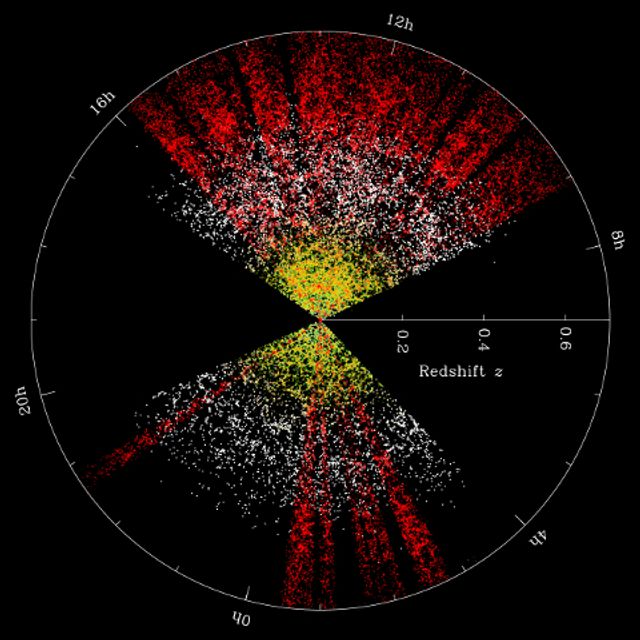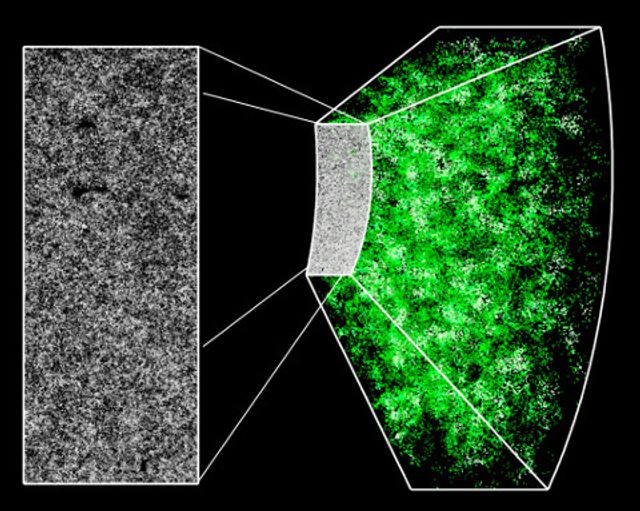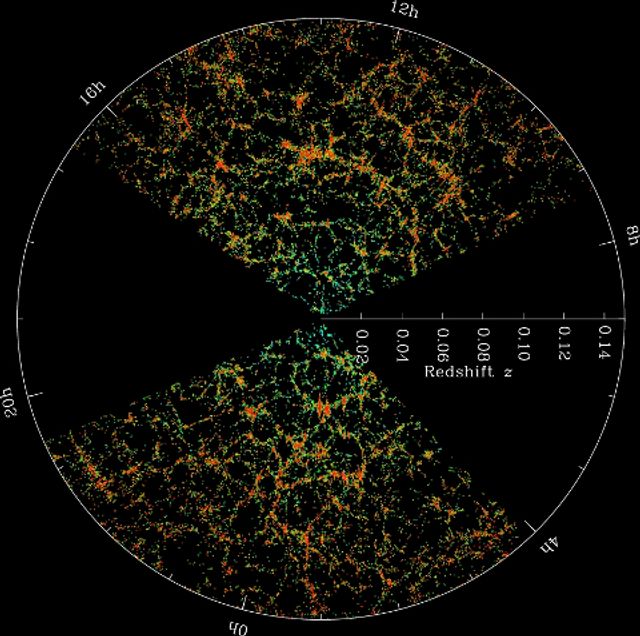Joe Mount
An international collaboration of astronomers has announced the latest results from the Baryon Oscillation Spectroscopic Survey (BOSS) experiment, which ran from 2008 to 2014 as part of the Sloan Digital Sky Survey (SDSS). The research collated a three-dimensional map of distant galaxies, enabling scientists to make the most precise measurements yet of dark energy and the acceleration of the expansion of the Universe, and to study the early, formative years of the cosmos.
Astronomer Jeremy Tinker said, “We have spent five years collecting measurements of 1.2 million galaxies over one quarter of the sky to map out the structure of the Universe over a volume of 650 billion cubic light years.” The latest map extends about twice as far as the previous sky survey, providing unprecedented insight into the evolution of the Universe by examining the distribution of galaxy clusters.
 Galaxies measured by the latest survey are shown in red, with galaxies from previous surveys shown in white and yellow. Red shift is a way to measure distances (and velocities) on a cosmological scale. An object with a red shift of 0.6 is approximately 8 billion light years away. Credit: Michael Blanton
Galaxies measured by the latest survey are shown in red, with galaxies from previous surveys shown in white and yellow. Red shift is a way to measure distances (and velocities) on a cosmological scale. An object with a red shift of 0.6 is approximately 8 billion light years away. Credit: Michael Blanton
The Sloan Digital Sky Survey project began in 2000 and systematically builds comprehensive maps of the distribution of galaxies across vast stretches of the observable Universe, covering one quarter of the sky. It uses a 2.5-meter diameter telescope at Apache Point Observatory in New Mexico that takes both a survey of objects (such as galaxies) distant from Earth and more detailed measurements of those already known. It has observed over 500 million astronomical objects and discovered a ring of stars surrounding our galaxy, the Milky Way.
 This image captures one tenth of the total sky survey. The image on the left is the view of space as seen from Earth. The wedge shows the same image as part of the map of galaxies in three dimensions. Each dot represents a galaxy containing several hundred billion stars. The brighter regions represent dense galactic clusters. Credit: Jeremy Tinker and the SDSS-III collaboration
This image captures one tenth of the total sky survey. The image on the left is the view of space as seen from Earth. The wedge shows the same image as part of the map of galaxies in three dimensions. Each dot represents a galaxy containing several hundred billion stars. The brighter regions represent dense galactic clusters. Credit: Jeremy Tinker and the SDSS-III collaboration
One of the early results from the SDSS project was that galaxies are not spread uniformly throughout space, but form filaments that span cosmological distances and have a clumpy structure with dense clusters and sparse voids. This is seen both in galaxies nearby and in structures much farther out (and thus further back in time). Astronomers have probed through 7 billion years of cosmic history and have found filament structures across all of it.
 A two-dimensional slice of space where each point represents a galaxy, colour-coded by brightness, clearly showing filaments and clusters. Earth is at the centre. Credit: M. Blanton and the Sloan Digital Sky Survey
A two-dimensional slice of space where each point represents a galaxy, colour-coded by brightness, clearly showing filaments and clusters. Earth is at the centre. Credit: M. Blanton and the Sloan Digital Sky Survey
It is thought that these filaments and voids are a result of the conditions of the Universe in its earliest years. For the first 400,000 years after the Big Bang, the Universe consisted of dense but expanding opaque gas, too hot to allow stable atoms to form. The gas was not perfectly uniform: very slight lumps of density produced areas of higher pressure. Each area of higher pressure sent a wave of pressure (essentially a sound wave) away from it throughout the early Universe, travelling at high speed until the Universe cooled and became transparent, freezing out the sound waves into an enduring imprint. The physics behind these sound waves are called baryon acoustic oscillations.
The scale of this clumping has been precisely measured by analysing the cosmic microwave background (CMB) radiation. The CMB provides a snapshot of the Universe at a time 378,000 years after the Big Bang when the hot gas of the early Universe cooled sufficiently to form atoms. Protons and electrons combined for the first time and thus electromagnetic radiation was able to travel freely through space. Some of this still reaches Earth today as radio waves: 1 percent of the noise a person hears when a radio is between stations is caused by this echo from the early Universe.
A few hundred million years later, the matter clumps provided the raw material for the formation of stars. As the Universe grew, this structure crystallised into vast filaments of galaxy clusters. In this way, the sound waves in the early Universe determined the large-scale distribution of matter in the Universe today, 13.8 billion years later. The spherical ripples in the distribution of galaxies are now 980 million light years across.
The BOSS experiment observed these ripples as the underlying space expanded over a period of 5 billion years, from 7 billion years ago to 2 billion years ago. It is through these structures that cosmologists study the pull of dark matter on galaxies and how dark energy is pushing them apart.
One can also begin to understand dark matter and dark energy through these observations. Initially, dark matter was thought to be dead stars, planets and/or black holes in massive quantities making halos around galaxies. Another idea, proposed more recently, is that dark matter is a new type of fundamental particle (or new class of particles) that are not part of normal particle physics. The baryon acoustic oscillations show that dark matter is most likely a whole new type of matter, of which the only known properties are that it does not emit light and is extremely massive.
Dark energy is even more of a mystery. Proposals for what it could be include a type of energy inherent to the vacuum of deep space, an effect of gravity over cosmological scales, some sort of quantum mechanical effect and a host of other potential phenomena. All that is really known is that dark energy is the name given by researchers for the energy that is causing the expansion of the Universe to accelerate.
This acceleration has been known since 1998, one of the first major discoveries of the Hubble Space Telescope. The discovery was made by studying a particular class of exploding stars, Supernovae Type Ia, which have a very distinct signature even across vast distances and thus can be used to measure accurately how far away distant galaxies are from Earth. Not only were these stars and galaxies found to be far away, but the measurement of the expansion velocities of these stars over cosmic distances, and thus cosmic time, provided a shock: instead of the expansion of the Universe slowing down over time, a result of the attraction of gravity, the expansion rate actually is speeding up!
The discovery revolutionised cosmology, as acknowledged by the 2011 Nobel Prize for Physics, and has since been confirmed by various independent measurements. The origin of the cosmic acceleration, now termed “dark energy,” is one of the biggest problems of modern cosmology.
To explain the cosmic acceleration, theorists retrieved Albert Einstein’s cosmological constant from the dustbin. Einstein arbitrarily inserted this effect into his theory of general relativity as a mechanism to counteract gravity and maintain the Universe at a stable, constant size. This corresponded to the widely held preconception that the Universe must be static and everlasting. He abandoned his “biggest blunder” after Edwin Hubble found in 1929 that the Universe was expanding.
Until the discovery of the cosmic acceleration it was assumed that the cosmological constant was zero and the Universe would either stabilise at a constant size or collapse in on itself in a “Big Crunch.” Now, the cosmological constant had to be given a non-zero value to account for the cosmic acceleration, which would cause the Universe to expand indefinitely.
Dark energy is the physical mechanism proposed to explain this acceleration. It is not an “anti-gravity” force that repels objects but an omnipresent phenomenon which increases the volume of space in regions of the Universe that are devoid of galactic clusters (the voids discussed earlier). Dark energy has never been directly observed in the laboratory, and its existence is inferred from cosmological observations. These observations suggest that dark energy comprises about 70 percent of the energy in the Universe.
The observations also support the “vacuum energy” theory of dark energy, one of the many competing models attempting to explain the cosmic acceleration. Essentially, the vacuum energy theory is that the amount of dark energy density is constant over time, as described by the cosmological constant. It is worth noting that this result is also supported by data from the survey reaffirming the validity of the general theory of relativity.
The BOSS experiment also confirmed that on cosmological scales the geometry of space-time is flat to within 0.1 percent. General relativity explains how massive objects induce space-time curvature that appears to us as the force of gravity. Across cosmological distances, the curvature of space-time tells us important things about the nature of the Universe. It may be flat like a sheet of paper, curved and “open” like a saddle or “closed” like a ball. A closed Universe must be finite in size, but a flat or open Universe may extend infinitely.
A number of further galactic surveys are planned for the coming decades. One of these is the Dark Energy Spectroscopic Instrument (DESI), which will use a larger telescope to probe fainter and more distant galaxies. Other works expanding and deepening the results of the third Sloan Digital Sky Survey are the fourth Sloan Digital Sky Survey (2014-2020), HETDEX, eBOSS and 4MOST. Physicist Stephen Hawking recently announced an effort by the COSMOS supercomputing centre to produce the most detailed map of the Universe to date. Simultaneously, the European Space Agency is planning the Euclid space mission, scheduled for launch in 2020, to build a similar map to investigate dark energy.
No comments:
Post a Comment